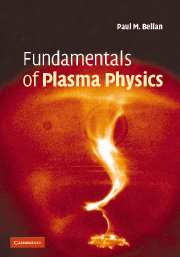Book contents
- Frontmatter
- Contents
- Preface
- 1 Basic concepts
- 2 The Vlasov, two-fluid, and MHD models of plasma dynamics
- 3 Motion of a single plasma particle
- 4 Elementary plasma waves
- 5 Streaming instabilities and the Landau problem
- 6 Cold plasma waves in a magnetized plasma
- 7 Waves in inhomogeneous plasmas and wave-energy relations
- 8 Vlasov theory of warm electrostatic waves in a magnetized plasma
- 9 MHD equilibria
- 10 Stability of static MHD equilibria
- 11 Magnetic helicity interpreted and Woltjer–Taylor relaxation
- 12 Magnetic reconnection
- 13 Fokker–Planck theory of collisions
- 14 Wave–particle nonlinearities
- 15 Wave–wave nonlinearities
- 16 Non-neutral plasmas
- 17 Dusty plasmas
- Appendices
- Bibliography and suggested reading
- References
- Index
1 - Basic concepts
Published online by Cambridge University Press: 05 June 2012
- Frontmatter
- Contents
- Preface
- 1 Basic concepts
- 2 The Vlasov, two-fluid, and MHD models of plasma dynamics
- 3 Motion of a single plasma particle
- 4 Elementary plasma waves
- 5 Streaming instabilities and the Landau problem
- 6 Cold plasma waves in a magnetized plasma
- 7 Waves in inhomogeneous plasmas and wave-energy relations
- 8 Vlasov theory of warm electrostatic waves in a magnetized plasma
- 9 MHD equilibria
- 10 Stability of static MHD equilibria
- 11 Magnetic helicity interpreted and Woltjer–Taylor relaxation
- 12 Magnetic reconnection
- 13 Fokker–Planck theory of collisions
- 14 Wave–particle nonlinearities
- 15 Wave–wave nonlinearities
- 16 Non-neutral plasmas
- 17 Dusty plasmas
- Appendices
- Bibliography and suggested reading
- References
- Index
Summary
History of the term “plasma”
In the mid nineteenth century the Czech physiologist Jan Evangelista Purkinje introduced use of the Greek word plasma (meaning “formed” or “molded”) to denote the clear fluid that remains after removal of all the corpuscular material in blood. About half a century later, the American scientist Irving Langmuir proposed in 1922 that the electrons, ions, and neutrals in an ionized gas could similarly be considered as corpuscular material entrained in some kind of fluid medium and called this entraining medium plasma. However it turned out that, unlike blood where there really is a fluid medium carrying the corpuscular material, there actually is no “fluid medium” entraining the electrons, ions, and neutrals in an ionized gas. Ever since, plasma scientists have had to explain to friends and acquaintances that they were not studying blood!
Brief history of plasma physics
In the 1920s and 1930s a few isolated researchers, each motivated by a specific practical problem, began the study of what is now called plasma physics. This work was mainly directed towards understanding (i) the effect of ionospheric plasma on long-distance short-wave radio propagation and (ii) gaseous electron tubes used for rectification, switching, and voltage regulation in the pre-semiconductor era of electronics. In the 1940s Hannes Alfvén developed a theory of hydromagnetic waves (now called Alfvén waves) and proposed that these waves would be important in astrophysical plasmas.
- Type
- Chapter
- Information
- Fundamentals of Plasma Physics , pp. 1 - 33Publisher: Cambridge University PressPrint publication year: 2006
- 1
- Cited by



